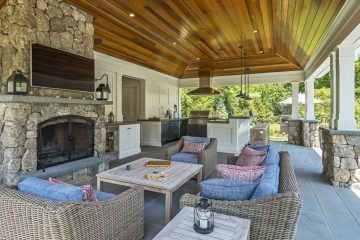Open floor plans have become synonymous with modern living, embodying a spacious and interactive environment. These designs blur the traditional boundaries between living, dining, and kitchen spaces, fostering a harmonious and social living experience. However, like any architectural design, open floor plans come with their unique set of benefits and challenges. We delve into an explorative analysis, painting a balanced picture to guide homeowners in making informed decisions.
The Upsides of Open Floor Plans
Spatial Fluidity and Versatility
One of the most celebrated advantages of open floor plans is the illusion of enhanced space. By eliminating unnecessary walls, spaces breathe freely, imbued with a sense of expansiveness and fluidity. This design facilitates multifunctional areas that are adaptable and versatile, catering to varied activities and social interactions.
Enhanced Natural Light
Without walls to obstruct their flow, natural light streams through the spaces unimpeded, creating an ambiance of warmth and brightness. This not only elevates the aesthetic allure but reduces the dependency on artificial lighting, leading to energy savings and a touch of eco-friendliness.
The Intersection of Social Connectivity and Aesthetics
Social Integration
Open floor plans promote social cohesion. The seamless flow between the kitchen, dining, and living areas fosters interaction and connectivity among family members. It facilitates conversations, engagement, and a shared living experience, embodying a familial synergy that’s as emotional as it is spatial.
Aesthetic Cohesion
The visual continuity in open floor plans offers a canvas for aesthetic creativity. Decor, color schemes, and design elements flow uninterrupted, offering a cohesive and harmonious visual experience. It’s a narrative of aesthetic fluidity, where spaces, though distinct in functionality, are united in visual harmony.
Navigating the Challenges
Noise and Privacy Concerns
However, the beauty of open spaces brings along the challenge of noise and privacy. In the absence of dividing walls, sound travels freely, sometimes leading to disruptions and a lack of privacy. It’s a space where the laughter from the living area can seamlessly drift into the quietude of the study corner, marking an intersection of sounds and activities.
Climate Control
The expansive nature of open floor plans can sometimes complicate climate control. Heating or cooling such spaces requires strategic placement of vents, efficient systems, and sometimes, higher energy consumption. It’s a dance of temperature where the warmth and chill are shared, echoing the communal ethos of open designs.
Real-Life Implementations and Adaptations
Adaptive Designs
Architects and homeowners are exploring adaptive design solutions to mitigate the challenges of open floor plans. Sliding doors, movable partitions, and strategic furniture placement are employed to create pseudo-boundaries, offering the flexibility of both open and segmented spaces. It’s an adaptive narrative where spaces are fluid, transforming in response to the inhabitants’ needs.
Integrated Technology
Technology plays a pivotal role in optimizing open floor plans. Smart climate control systems, noise-cancellation technologies, and automated privacy solutions are integrated to enhance comfort, privacy, and energy efficiency. In this narrative, technology is the silent orchestrator, ensuring the open spaces are as functional as they are aesthetic.
Striking the Balance
In the world of open floor plans, the harmony of benefits and challenges crafts a living experience that’s as dynamic as it is stationary. It’s a space where the robustness of rebar benders that craft foundational structures meets the ethereal softness of natural light.
Strategic Planning
Success in open floor plans lies in strategic planning. It’s about integrating design innovations, technological solutions, and aesthetic creativity to craft spaces that echo with the expansive ethos of open designs yet are imbued with privacy, comfort, and functional distinction.
The Evolutionary Narrative
As we step into the future, open floor plans are not static but evolutionary. They are spaces in metamorphosis, echoing the dynamic nature of modern living. Every benefit is celebrated; every challenge, an opportunity for innovation; every space, a silent canvas of the evolving human narrative.
Conclusion
In essence, open floor plans are dialogues between spaces and inhabitants, sounds and silences, light and shadow, privacy and openness. It’s a world where the structural integrity crafted by tools like rebar benders meets the aesthetic fluidity of unbounded spaces. Each home, a narrative; each open space, a chapter; each challenge and benefit, the silent verses of a tale where walls dissolve, spaces merge, and living transcends the physical boundaries to echo with the harmonious hymns of familial connectivity, aesthetic elegance, and innovative adaptation.


